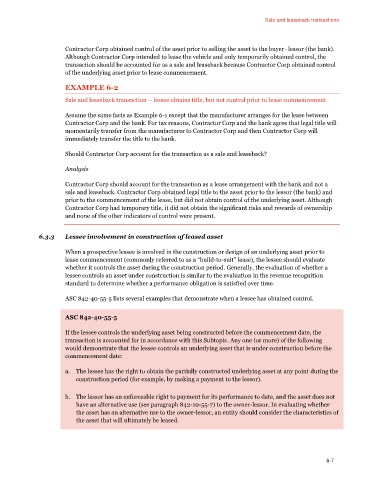Page 214 - pwc-lease-accounting-guide_Neat
P. 214
Sale and leaseback transactions
Contractor Corp obtained control of the asset prior to selling the asset to the buyer- lessor (the bank).
Although Contractor Corp intended to lease the vehicle and only temporarily obtained control, the
transaction should be accounted for as a sale and leaseback because Contractor Corp obtained control
of the underlying asset prior to lease commencement.
EXAMPLE 6-2
Sale and leaseback transaction – lessee obtains title, but not control prior to lease commencement
Assume the same facts as Example 6-1 except that the manufacturer arranges for the lease between
Contractor Corp and the bank. For tax reasons, Contractor Corp and the bank agree that legal title will
momentarily transfer from the manufacturer to Contractor Corp and then Contractor Corp will
immediately transfer the title to the bank.
Should Contractor Corp account for the transaction as a sale and leaseback?
Analysis
Contractor Corp should account for the transaction as a lease arrangement with the bank and not a
sale and leaseback. Contractor Corp obtained legal title to the asset prior to the lessor (the bank) and
prior to the commencement of the lease, but did not obtain control of the underlying asset. Although
Contractor Corp had temporary title, it did not obtain the significant risks and rewards of ownership
and none of the other indicators of control were present.
6.3.3 Lessee involvement in construction of leased asset
When a prospective lessee is involved in the construction or design of an underlying asset prior to
lease commencement (commonly referred to as a “build-to-suit” lease), the lessee should evaluate
whether it controls the asset during the construction period. Generally, the evaluation of whether a
lessee controls an asset under construction is similar to the evaluation in the revenue recognition
standard to determine whether a performance obligation is satisfied over time.
ASC 842-40-55-5 lists several examples that demonstrate when a lessee has obtained control.
ASC 842-40-55-5
If the lessee controls the underlying asset being constructed before the commencement date, the
transaction is accounted for in accordance with this Subtopic. Any one (or more) of the following
would demonstrate that the lessee controls an underlying asset that is under construction before the
commencement date:
a. The lessee has the right to obtain the partially constructed underlying asset at any point during the
construction period (for example, by making a payment to the lessor).
b. The lessor has an enforceable right to payment for its performance to date, and the asset does not
have an alternative use (see paragraph 842-10-55-7) to the owner-lessor. In evaluating whether
the asset has an alternative use to the owner-lessor, an entity should consider the characteristics of
the asset that will ultimately be leased.
6-7

